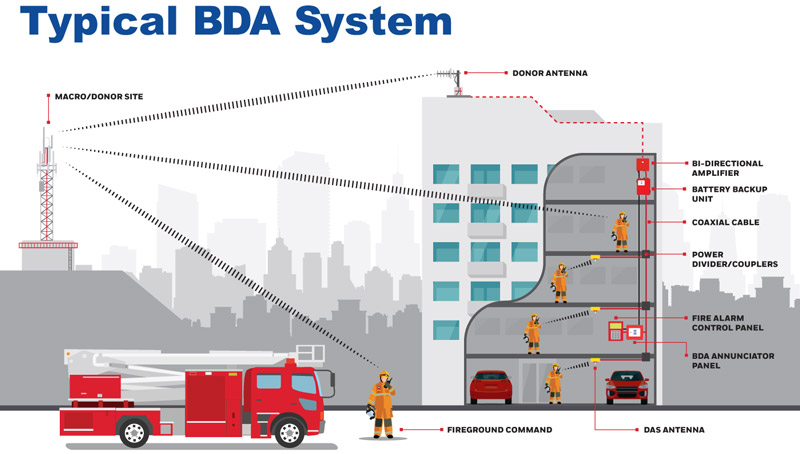

ERCES Solutions for Commercial Buildings
Keep emergency communications out of the dead zone
Every minute counts when it comes to helping save people and property during an emergency. First responders need to have clear and concise radio communication in all areas of a building — especially in spaces where signal can be lost. In many buildings, there are areas called “dead spots” that unintentionally minimize the radio signal strength, making it challenging for anyone to communicate effectively via radio. The signals may be obstructed by structures such as concrete, Low-E glass windows, metal, underground structures and additional materials that impact the propagation of radio signals. In these dead spots, the signal is not strong enough to allow emergency communication hardware, such as two-way radios, to communicate with each other, negatively impacting first responders' ability to communicate about and address emergency situations.

To help address the coverage problem first responders face, Emergency Responder Communication Enhancement Systems (ERCES) were first introduced in the 2009 International Building Code. The ERCES requirement was established to address the performance of emergency responders' portable radios inside buildings because building construction, building size, construction features and other elements can absorb or block radio communications. Today's codes like the IBC 2021 Section 916, NFPA 1 2021 Section 11.10, IFC 2021 Section 510, 2019 NFPA 1221 Section 9.6 or 2022 NFPA 1225 Chapter 18 require all buildings to have an approved level of in-building emergency communication coverage for emergency responders. This approved level of coverage is based on the existing coverage levels of the public safety communication systems of the jurisdiction at the exterior of the building.
The code-required level of radio coverage can be achieved by enhancing the in-building radio frequency signal coverage with an ERCES system, also commonly referred to as a Bi-Directional Amplifier (BDA) system. An ERCES/BDA system's operation is straightforward: the radio signal from a responder's two-way radio reaches an antenna inside a building and is amplified both by other interior antennae for in-building communication, as well as an antenna on the roof to facilitate external public safety radio system communications. The system is designed so that radio signals from the public safety antenna reach first responders inside the building through the same method in reverse. These mechanisms all work together to enable first responders to have a clear, concise conversation when it matters most.
ERCES systems are comprised of a BDA, Distributed Antenna System (DAS), donor antenna, dedicated annunciator panel and power components. The BDA serves as a signal boosting device that sustains two-way communications and amplifies a signal while the DAS and donor antenna receive and transmit signals. BDAs work to both transmit and receive signals throughout a facility — including stairwells, underground tunnels, parking garages and other challenging areas. The dedicated annunciator panel is required by code to display six potential trouble conditions. It will let the responder or facility manager know if there is an issue like a low battery or problems with the signal booster. The power supply includes a battery charging system to offer backup power if the building loses power during an emergency event.

Specifically designed to meet NFPA and IBC/IFC code compliance, a Fiplex by Honeywell BDA system enhances two-way radio signal strength inside buildings, tunnels and other structures and is an ideal solution to solve the coverage problem. A Fiplex BDA system offers a digital class A/B low to high power (0.5W to 5W) radio signal booster system that can be designed and customized to meet all public safety frequency band ranges: 700 MHz, 800 MHz, VHF, UHF and FirstNet Band 14 support with single/dual band. Fiplex BDA solutions are developed to provide some of the best amplification and coverage performance, and at the same time improve reliability of the radio network with no noise. From software-defined configuration to innovative features that support mission-critical success, Fiplex BDAs are configurable to almost all jurisdictions, codes and buildings.
Value of a Fiplex by Honeywell BDA System:
The G in 4G stands for generation, so 4G is the fourth generation of cellular network technology. In some cases, you may see or hear the term 4G LTE. The term LTE applies more generally to the idea of improving wireless broadband speeds to meet increasing demand; 4G LTE is faster than 3G but slower than true 4G.
Some of the benefits of newer 4G and 4G LTE products and devices include:
ERCES/BDA systems in emergencies help improve the signal in all areas of a building. With strong radio signal coverage, emergency officials can effectively communicate with each other in challenging circumstances. The state-of-the-art BDA system from Fiplex by Honeywell is an industry leading user-friendly, mission-critical solution offering flexibility to address multiple applications across different jurisdictions with a lower total cost of ownership. Fiplex by Honeywell BDA systems help solve the coverage problem by enhancing the radio frequency coverage needed to keep first responders connected and protected so they can help save more lives.